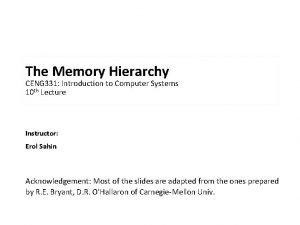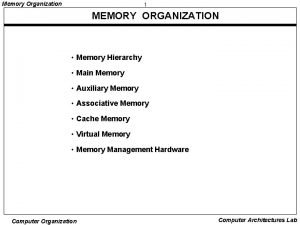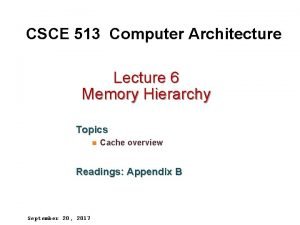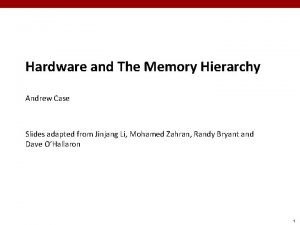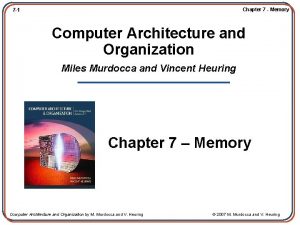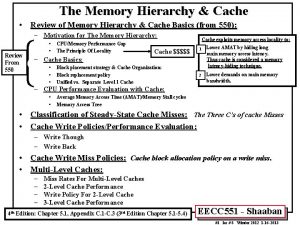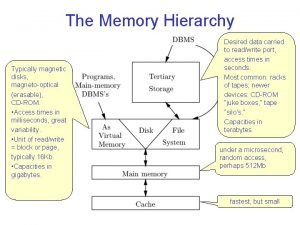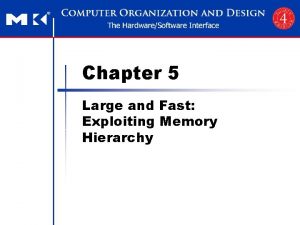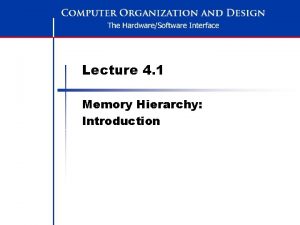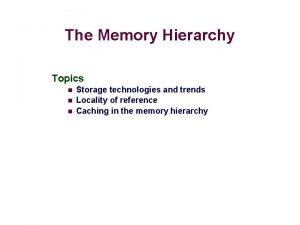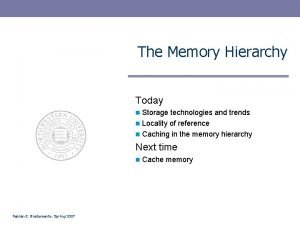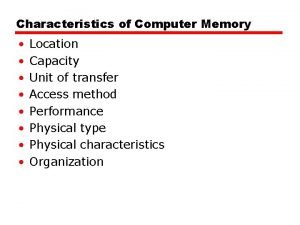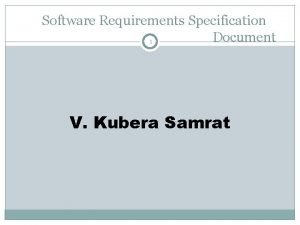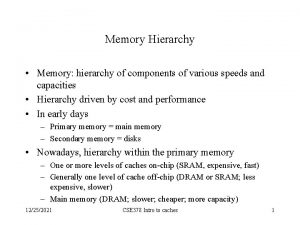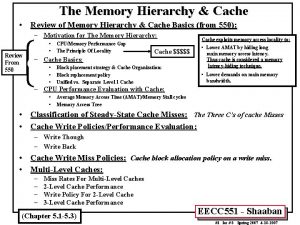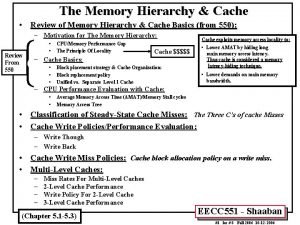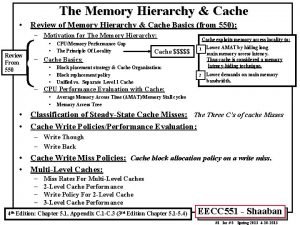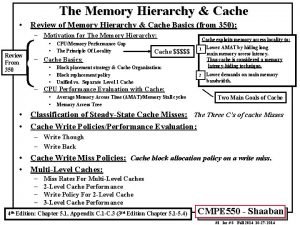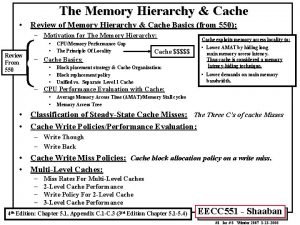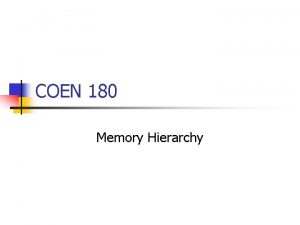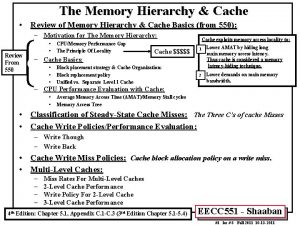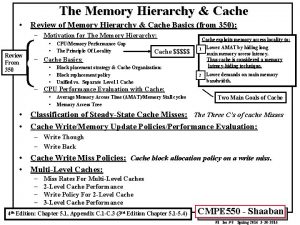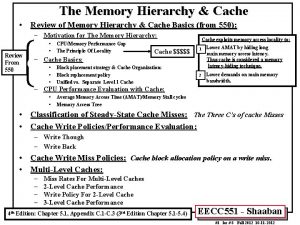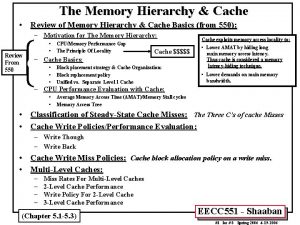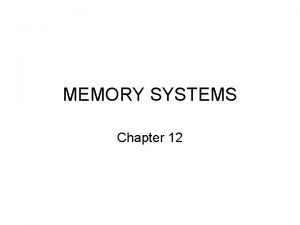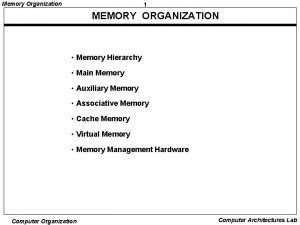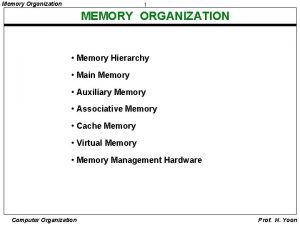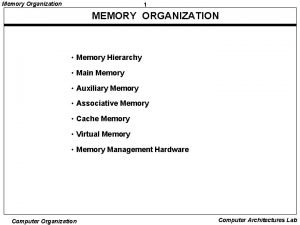Memory Hierarchy Memory hierarchy of components of various
































- Slides: 32

Memory Hierarchy • Memory: hierarchy of components of various speeds and capacities • Hierarchy driven by cost and performance • In early days – Primary memory = main memory – Secondary memory = disks • Nowadays, hierarchy within the primary memory – One or more levels of cache on-chip (SRAM, expensive, fast) – Generally one level of cache off-chip (DRAM or SRAM; less expensive, slower) – Main memory (DRAM; slower; cheaper; more capacity) 8/27/2021 CSE 378 Intro to caches 1

Goal of a memory hierarchy • Keep close to the ALU the information that will be needed now and in the near future – Memory closest to ALU is fastest but also most expensive • So, keep close to the ALU only the information that will be needed now and in the near future • Technology trends – Speed of processors (and SRAM) increase by 60% every year, though it’s beginning to slow – Latency of DRAMS decrease by 7% every year – Hence the processor-memory gap or the memory wall bottleneck 8/27/2021 CSE 378 Intro to caches 2

Processor-Memory Performance Gap • • x Memory latency decrease (10 x over 8 years but densities have increased 100 x over the same period) o x 86 CPU speed (100 x over 10 years) 1000 Pentium III o Pentium Pro o Pentium o 100 386 o 10 x “Memory gap” x x x Pentium IV o “Memory wall” x x 99 01 1 89 8/27/2021 91 93 95 97 CSE 378 Intro to caches 3

Typical numbers Technology SRAM Disk 8/27/2021 Typical access time 0. 5 -5 ns 50 -70 ns 5 M-20 M ns CSE 378 Intro to caches $/Gbyte $4 K-$10 K $100 -200 $0. 50 -$2 4

Principle of locality • A memory hierarchy works because code and data are not accessed randomly • Computer programs exhibit the principle of locality – Temporal locality: data/code used in recent past is likely to be reused in the future (e. g. , code in loops, data in stacks) – Spatial locality: data/code close (in memory addresses) to the data/code that is being presently referenced will be referenced in the near future (straight-line code sequence, traversing an array) 8/27/2021 CSE 378 Intro to caches 5

Caches • Registers are not sufficient to keep enough data locality close to the ALU • Main memory (DRAM) is too “far”. It takes many cycles to access it – Instruction memory is accessed every cycle • Hence need of fast memory between main memory and registers. This fast memory is called a cache. – A cache is much smaller (in amount of storage) than main memory • Goal: keep in the cache what’s most likely to be referenced in the near future 8/27/2021 CSE 378 Intro to caches 6

Basic use of caches • When fetching an instruction, first check to see whether it is in the cache – If so (cache hit) bring the instruction from the cache to the IR. – If not (cache miss) go to next level of memory hierarchy, until found • When performing a load, first check to see whether it is in the cache – If cache hit, send the data from the cache to the destination register – If cache miss go to next level of memory hierarchy, until found • When performing a store, several possibilities – Ultimately, though, the store has to percolate to main memory 8/27/2021 CSE 378 Intro to caches 7

Levels in the memory hierarchy SRAM; a few ns SRAM/DRAM; 10 -20 ns DRAM; 40 -100 ns a few milliseconds 64 -128 ALU registers On-chip caches: split I-cache; D-cache 8 -64 KB (level 1) 64 KB – 2 MB (level 2) Off-chip cache; 128 KB - 8 MB Main memory; up to 4 GB Secondary memory; 10 -100’s of GB Archival storage 8/27/2021 CSE 378 Intro to caches 8

Caches are ubiquitous • Not a new idea. First cache in IBM System/85 (late 60’s) • Concept of cache used in many other aspects of computer systems – disk cache, network server cache, web cache etc. • Works because programs exhibit locality • Lots of research on caches in last 25 years because of the increasing gap between processor speed and (DRAM) memory latency • Every current microprocessor has a cache hierarchy with at least one level on-chip 8/27/2021 CSE 378 Intro to caches 9

Main memory access (review) • Recall: – In a Load (or Store) the address is an index in the memory array – Each byte of memory has a unique address, i. e. , the mapping between memory address and memory location is unique ALU Address Main Mem 8/27/2021 CSE 378 Intro to caches 10

Cache Access for a Load or an Instr. fetch • Cache is much smaller than main memory – Not all memory locations have a corresponding entry in the cache at a given time • When a memory reference is generated, i. e. , when the ALU generates an address: – There is a look-up in the cache: if the memory location is mapped in the cache, we have a cache hit. The contents of the cache location is returned to the ALU. – If we don’t have a cache hit (cache miss), we have to look in next level in the memory hierarchy (i. e. , other cache or main memory) 8/27/2021 CSE 378 Intro to caches 11

Cache access ALU How do you know where to look? How do you know if there is a hit? Main memory is accessed only if there was a cache miss 8/27/2021 Address hit Cache miss Main memory CSE 378 Intro to caches 12

Some basic questions on cache design • When do we bring the contents of a memory location into the cache? • Where do we put it? • How do we know it’s there? • What happens if the cache is full and we want to bring something new? – In fact, a better question is “what happens if we want to bring something new and the place where it’s supposed to go is already occupied? ” 8/27/2021 CSE 378 Intro to caches 13

Some “top level” answers • When do we bring the contents of a memory location in the cache? -- The first time there is a cache miss for that location, that is “on demand” • Where do we put it? -- Depends on cache organization (see next slides) • How do we know it’s there? -- Each entry in the cache carries its own name, or tag • What happens if the cache is full and we want to bring something new? One entry currently in the cache will be replaced by the new one 8/27/2021 CSE 378 Intro to caches 14

Generic cache organization Address Address or tag 8/27/2021 Generated by ALU data data Cache entry or cache block or cache line If address (tag) generated by ALU = address (tag) of a cache entry, we have a cache hit; the data in the cache entry is good CSE 378 Intro to caches 15

Cache organizations • Mapping of a memory location to a cache entry can range from full generality to very restrictive – In general, the data portion of a cache block contains several words • If a memory location can be mapped anywhere in the cache (full generality) we have a fully associative cache • If a memory location can be mapped at a single cache entry (most restrictive) we have a direct-mapped cache • If a memory location can be mapped at one of several cache entries, we have a set-associative cache 8/27/2021 CSE 378 Intro to caches 16

How to check for a hit? • For a fully associative cache – Check all tag (address) fields to see if there is a match with the address generated by ALU – Very expensive if it has to be done fast because need to perform all the comparisons in parallel – Fully associative caches do not exist for general-purpose caches • For a direct mapped cache – Check only the tag field of the single possible entry • For a set associative cache – Check the tag fields of the set of possible entries 8/27/2021 CSE 378 Intro to caches 17

Cache organization -- direct-mapped • Most restricted mapping – Direct-mapped cache. A given memory location (block) can only be mapped in a single place in the cache. Generally this place given by: (block address) mod (number of blocks in cache) 8/27/2021 18

Direct-mapped cache C lines 8/27/2021 All addresses mod C map to the same cache block C lines Main memory CSE 378 Intro to caches 19

Fully-associative cache • Most general mapping – Fully-associative cache. A given memory location (block) can be mapped anywhere in the cache. – No cache of decent size is implemented this way but this is the (general) mapping for pages from virtual to physical space (disk to main memory, see later) and for small TLB’s (this will also be explained soon). 8/27/2021 CSE 378 Intro to caches 20

Fully-associative cache Cache Any memory block can map to any cache block 8/27/2021 CSE 378 Intro to caches Main memory 21

Set-associative caches • Less restricted mapping – Set-associative cache. Blocks in the cache are grouped into sets and a given memory location (block) maps into a set. Within the set the block can be placed anywhere. Associativities of 2 (two-way set-associative), 4, 8 and even 16 have been implemented. • Direct-mapped = 1 -way set-associative • Fully associative with m entries is m-way set associative 8/27/2021 22

Set-associative cache Cache Bank 0 Bank 1 A memory block maps into a specific block of either set Main memory 8/27/2021 CSE 378 Intro to caches 23

Design Choices • Abstract alternatives by: indexing selecting – indexing picks a row – selecting picks a column Fully Assoc 2 -Way Set Assoc Direct Mapped 8/27/2021 CSE 378 Intro to caches 24

Cache hit or cache miss? • How to detect if a memory address (a byte address) has a valid image in the cache: • Address is decomposed in 3 fields: – block offset or displacement (depends on block size) – index (depends on number of sets and set-associativity) – tag (the remainder of the address) • The tag array has a width equal to tag 8/27/2021 25

Hit detection (direct-mapped cache) These fields have the same size Tag index tag tag tag data data tag data d d corresponds to number of bytes in the block; index corresponds to number of blocks in the cache; tag is the remaining bits in the address. If tag(gen. address) = tag(entry pointed at by index in cache), we have a hit 8/27/2021 CSE 378 Intro to caches 26

Example of a direct-mapped cache • DEC Station 3100 – 64 KB (when giving the size, or capacity, of a cache, only the data part is counted) – Each block is 4 bytes (block size); hence 16 K blocks (aka lines) – displacement field: d = 2 bits (d = log 2 (block size) ) – index field: i = 14 bits (i = log 2 (nbr of blocks) ) – tag field : t = 32 - 14 -2 = 16 bits 8/27/2021 CSE 378 Intro to caches 27

DEC 3100 8/27/2021 CSE 378 Intro to caches 28

Multiword Cache 8/27/2021 CSE 378 Intro to caches 29

Benefits of Multiword Caches 8/27/2021 CSE 378 Intro to caches 30

Why set-associative caches? • Cons – The higher the associativity the larger the number of comparisons to be made in parallel for high-performance (can have an impact on cycle time for on-chip caches) • Pros – Better hit ratio – Great improvement from 1 to 2, less from 2 to 4, minimal after that 8/27/2021 31

Set associative mapping Index = log (number of blocks) / associativity Bank 1 Bank 0 Note: we need one comparator per bank + mux to see if we have a hit. 8/27/2021 CSE 378 Intro to caches 32
 Virtual memory in memory hierarchy consists of
Virtual memory in memory hierarchy consists of Memory hierarchy
Memory hierarchy What is memory organization
What is memory organization Memory hierarchy
Memory hierarchy Memory hierarchy
Memory hierarchy Hit ratio in computer architecture
Hit ratio in computer architecture Memory hierarchy in os
Memory hierarchy in os Draw memory hierarchy diagram
Draw memory hierarchy diagram Computer memory hierarchy diagram
Computer memory hierarchy diagram Magnetic disk in memory hierarchy
Magnetic disk in memory hierarchy Large and fast: exploiting memory hierarchy
Large and fast: exploiting memory hierarchy Explain memory hierarchy
Explain memory hierarchy Memory hierarchy
Memory hierarchy Memory hierarchy definition
Memory hierarchy definition Memory hierarchy in computer
Memory hierarchy in computer Hierarchy of trends
Hierarchy of trends Computer architecture
Computer architecture Dram memory mapping
Dram memory mapping Characteristics of computer memory
Characteristics of computer memory Memory hierarchy diagram
Memory hierarchy diagram Which memory is the actual working memory?
Which memory is the actual working memory? Internal memory and external memory
Internal memory and external memory Page fault
Page fault Episodic memory
Episodic memory Primary memory and secondary memory
Primary memory and secondary memory Eidetic memory vs iconic memory
Eidetic memory vs iconic memory Excplicit memory
Excplicit memory Physical address vs logical address
Physical address vs logical address Shared memory vs distributed memory
Shared memory vs distributed memory Long term memory vs short term memory
Long term memory vs short term memory Advantages and disadvantages of serotaxonomy
Advantages and disadvantages of serotaxonomy The srs document is useful in various contexts:
The srs document is useful in various contexts: Different levels of management
Different levels of management

